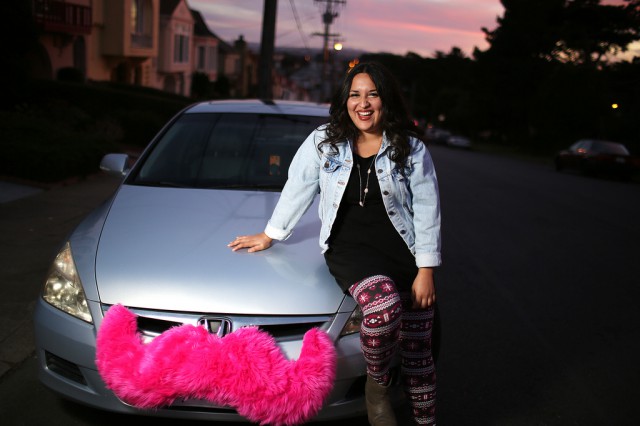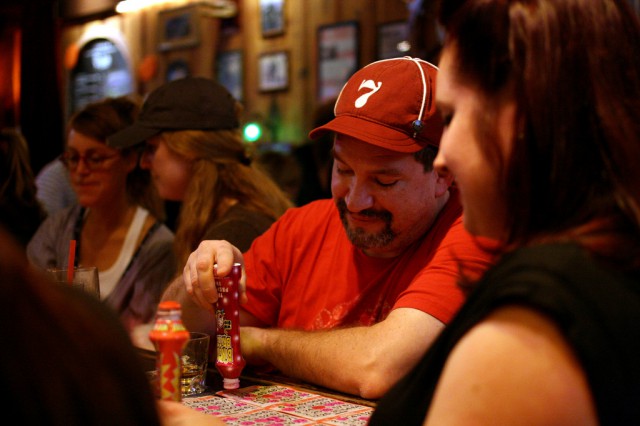
Written by Juilian Lim
Photos by Benjamin Kamps
Short around the ears and a fade to the top, which is left long to comb-over to one side—this is the gentleman’s cut.
This classic—associated with the dapper, post-World War II, American hairstyle—has made its way into the twenty-first century. Guys are now walking out of the throwback duel chair barbershops with their hair greased and side-saddled like a rockabilly Don Draper.
Barbers in the Bay Area have made the cut their own.
Julius Arriola and Junior Argente—formerly of Fresh Cuts Daly City—credit themselves with fusing the old-school style with the new-school line design.
Arriola coins it “the surgical part,” when the natural part of the combed-over hair is exaggerated with a razor-shaved line, made to look denser, wider, and longer. The cut finishes with a hook design, carved into the back of the hair.
“We claim that shit at Fresh Cuts,” Arriola says. “We helped bring that style back.”

As the story goes, in 2010, Arriola was in the process of growing out his hair and was planning on getting dreadlocks. One day, tired of his long hair, he had asked Argente to give him a pompadour cut. After it was finished, Arriola asked for a hook in his hair. Seeing that the design did not look quite right, he had Argente continue the hook from the front of his hair, and along the part line to the back of his head.
“Now, everybody rocks a combover with that cut,” boasts Arriola. “I was just in Vegas, and dude rocking the door at this club had the combover with surgical part. He probably had no idea that we had a hand in that.”
Argente remembers distinctly in 2010 that no one had the combover except for Arriola and himself.
“I don’t want to put it out there like we started it,” Argente says, “but I want to say that we brought it back.”
The combover with the surgical part is one example of how locals are pushing their way to the forefront of this rapidly inflating Bay Area industry. Aside from being trendsetters, the local scene is filled with vibrant characters, solid camaraderie, and rare opportunities.
This is ground zero for a renaissance, where the game is played differently and passion runs strong with each pass of the blade.
The Cut
The average haircut in San Francisco—with no fades, no tapers, and no line-ups—costs anywhere from fifteen to thirty-five dollars. On any given day, barbers like Arriola and Argente can expect a flow of about eight to ten clients. Usually, the owner charges weekly booth rental fees, which can range anywhere from one hundred to three hundred dollars. Factor in the median booth rental and haircut prices, and a good barber can make at least fifty thousand a year excluding tips, if they stick to just basic haircuts. That’s double the U.S. median annual wage for barbers.
The Bureau of Labor Statistics sets the barber’s median annual wage at twenty-five thousand dollars in the U.S., with the upper ninetieth percentile making a little over forty-three thousand dollars a year. This is chump change in the Bay Area where the price of the average haircut is much more.
Argente, who makes enough to live comfortably and support his one-year-old son, says that he used to be the shy guy that prospective clients would avoid.
“I used to fuck people up,” Argente says. “I was told, ‘the more people you cut, the more money you’d make.’ But toward the end at Fresh Cuts, I started to take my time, cutting eight people a day, getting paid twenty dollars, and not getting tipped. But I didn’t really care, because I liked how the product turned out. I was satisfied, and I was happy, and a lot of people noticed, including J.J.”
J.J. Tupas opened Cut to Contrast in June in the affluent Ingleside Terrace neighborhood. Tupas offered Argente and five others to take a chair in his shop. Cut to Contrast shares a business unit with a tattoo parlor, splitting the space into two narrow alleys with only a wall built between them. The seven top-of-the-line Alexander chairs in Cut to Contrast crowd the passageway, where walking straight across the shop would mean weaving slightly around each chair to reach the flat screen TV at the back of the shop.
Customers with appointments are pumped in as long as the barber pole outside is plugged in and spinning.
One of the guys who works at Cut to Contrast is twenty-six-year old Randy Tagle. He sports a pair of Buddy Holly’s with prescription lenses and a comb-over, complete with a surgical part that ends in the back of his neck where his hair line stops. The bottom half of the cut is bleached blond.
“I started to keep my circle of friends close,” Tagle says. “I would travel a lot, and barbering was something I could do to stay in touch with everyone. I would just cut them for free.”
Tagle, who has been cutting hair for thirteen years, was the second Filipino American to work at Chicago’s Barber Shop, a historically black establishment in San Francisco that’s been around since the 1930s.
The first Filipino American to work there was Anton Cura, who now owns Attention to Detail Barber Gallery. Cura is credited with breaking barriers for the mainstream Filipino American barbers in San Francisco.
Tagle has also received a considerable amount of YouTube attention from his tutorial videos and collects compensation as a Google Partner. Argente, who also works at Cut to Contrast, calls Tagle, “Mr. YouTube.” Saying that Tagle is one of the first people to make a thorough barbering tutorial video.
So far, Tagle has amassed more than fifteen thousand YouTube subscribers, and is just shy of six million views.
Tagle is also the president of the Bay Area Barber Brotherhood, a union in the making with just over one hundred and thirty subscribed to the mailing list. The four founding fathers—Phil Alapati of Phil Good Cuts, Derrick Pecson of Black and Gold Barber Lounge, Cura, and Tagle—developed the brotherhood as a vessel to unite those in the Bay Area industry into one collective being. Instead of being pitted against each other in competition, the union allowed for strong bonds and new relationships to form.
No one is singled out, as Tagle explains it. When they travel to events like hair battles, the BABB shows up as one team instead of small sprinklings of camps.
“We’re not a gang or anything like that,” Tagle says. “We’re a group of barbers from the Bay Area who get together, and who want to be a part of the same thing. Our motto is, ‘we’re not trying to shine on you, we’re trying to shine with you.’”
The Success
It does not take much to become a barber today. All that is needed are clippers and the faith of a clientele. For most, they started in the garage, cutting their friends and family members for five or ten dollars a head.
Arriola, an L.A. transplant from the Bay Area, came from the same humble garage beginnings eleven years ago. After his mom expressed how much she disliked paying for his simple haircut, Arriola started cutting his own with a set of clippers his mom bought at Target. It was an organic progression that followed, turning him into a heavy hitter in the industry.
“Julez is a dope barber,” says fellow barber and friend Jason Pulido, who owns The Cutlery shop in Daly City along with his business partner Jason Gragasin,

an SF State graduate. “By far, one of the cleanest I’ve seen. He loves what he does, he takes his time, he’s very personable. Not only that, the way he looks. It’s different. It’s edgy.”
Back in the day, Pulido worked out of his garage, and Arriola was one of his regulars.
“Him being in L.A. is probably one of the best moves he could have done,” Pulido says. “If somebody were to come up to me ask if there’s one barber in the Bay that can make it out in L.A., it would be Julez. He has all of the components to become something pretty big.”
Argente, who has been friends with Arriola since the fifth grade, says he is not surprised by the success and opportunities his friend has had.
“Don’t expect him to be a barber all his life,” says Argente, “I don’t want to give his secrets out, but he has a lot of big things going for him.”
Arriola’s Instagram account reveals he has amassed more than fifteen thousand followers. Aside from the thousands of haircuts he has done, he has pictures from a recent national hair battle in Las Vegas. He also flew out to Cold Cuts Barber Shop in Tokyo for a week to showcase the American style of barbering.
Every month, Arriola makes a trip out to Vegas to help cut the dance group The Jabbawokeez. Arriola has even been in Vice magazine when food-personality Eddie Huang visited the Bay Area in an episode of Fresh off the Boat.
Despite all that Arriola has achieved, he remembers his first shop.
“In the beginning,” he recalls, “I felt like we [Fresh Cuts Daly City] were the underdogs. A lot of people say that we started from the bottom. Truth is, we started a little bit below the bottom. After about two to three years in the game, we solidified ourselves in the community, and became a powerhouse in the barbering community. We were putting out one-hundred percent quality cuts as a team.”
The Education
In the Bay Area, tuition can cost up to eight thousand dollars for a stylist course. Usually there is no financial aid or grants, especially at the smaller operations. And if a parent does not help pay, the student generally has to work while committed to a program that runs three times a week for eleven hours a day for a total of fifteen-hundred hours, or about ten months.
“Back before the recession hit, there were tons of funding sources to help with tuition,” says Chris Diez, the assistant director and co-founder at the Bay Area Hair Institute in South San Francisco, and co-owner of Fine Line San Francisco. “Now there’s nothing out there. So a lot of our students actually have to work full-time to help supplement their time here.”
Alongside Diez is the Bay Area Hair Institute’s director Larry Summers who has been teaching the craft for the better part of ten years. Diez opened the South San Francisco school just a little over a year ago.
The twenty-chair college is located at the end of a strip mall, with half of the one-classroom building built over the driveway, acting as a makeshift tunnel leading to the mall’s small parking lot in the back. About every half hour or so, the sound of a commercial airline flying overhead rattles the classroom, blocking out the sun momentarily.
So far, the college holds a one-hundred percent completion rate according to the examination results from the California Board of Barbering and Cosmetology.
“Larry’s method is fail-proof,” Diez says. “Our students will have done the techniques we teach a million times before they go in. That’s why our passing rate is really good.”
The idea for Bay Area Hair Institute was concocted while Summers was having his hair cut by Diez. The goal was to create a college in a positive location that provides a solid education where students can not only learn the techniques of barbering, but also learn the professional aspect that comes with working in a shop.
Bay Area Hair Institute is night-and-day compared to the college where Summers taught before. Located on sixth street in the San Francisco Tenderloin neighborhood. San Francisco Barber College was one of the two main barber schools normally attended in San Francisco. The only other choice is one on Third Street in Bayview-Hunters Point.
San Francisco Barber, which was more commonly known as Sixth Street Barber College, had a notorious reputation of being gritty. The students who did their time there, remember the college well.
Summers, who had taught there for two years, said he can’t even begin to count how many times he had to wash off the human waste left on the front steps.
He remembers the fights that would happen there, sometimes involving the students. He remembers gun battles happening outside. Summers says that he had resorted to carrying a can of mace just in case things got out of control.
Summers eventually left Sixth Street due to “some funny business” that the owner got into. According to a citation notice issued by California’s Bureau for Private Postsecondary Education, the owner of Sixth Street was ordered to pay a fine of fifty thousand dollars or close its doors for operating without proper approval from the Bureau. The college was also ordered to pay back any tuition to students enrolled after March 2011. Sixth Street closed in March 2012.
The Test
It’s nine o’clock on a Friday, and Marc Diaz is curling hair.
His client is a silicone head affixed to a sawed-off piece of two-by-four and clamped to the back of a chair. The green-and-pink, eye-shadowed dummy stares at the Obama poster and the sun-faded haircut chart as Diaz twists the black-and-gold, curling iron through sections of human hair needled into the flesh-colored scalp.
He’s practicing for the California Board of Barbering and Cosmetology exam on Monday.
The test, which is a mixture between a written and a physical exam, covers everything from styling women’s hair to knowing the correct location of a fire extinguisher in a shop.
Diaz has a lot riding on this test.
When Argente left Fresh Cuts Daly City in June, he was asked to find someone to take over his chair. He found Diaz. The only problem—he was not state-certified yet.
He has been at Bayview Barber College on Third Street since June 2012. Diaz finished his classes and tests, and met the state-required fifteen hundred hours. The timing would have been perfect. But he failed the first time.
Now he is back, making use of his mornings to fine-tune the techniques he is not comfortable with in preparation for his next exam.
Exam Day
It’s four o’clock in the morning on Monday, and Diaz is driving to Fairfield where the state exam takes place in Northern California. He arrived early for some last-minute practicing.
Fifteen minutes after he was dismissed from the test, he learned he had made the cut. Like anyone would, Diaz took a picture of it and texted to his mom.
The day after he got his license, he moved his workstation from his garage to Fresh Cuts Daly City. The six-chair shop, which Arroila and Argente helped establish, is now Diaz’s home.
“I never thought that I would get into a shop like this,” says Diaz. “I’ve always been afraid of not finding a spot to work at after I graduated. But fortunately, I was able to work at a shop where I look up to everyone. I just thank God for finally getting me through it, that I never have to take this test ever again, and that I’ll never have to worry about perms or hair coloring ever again.”
Diaz will find himself immersed in the fast-evolving culture. There is no better place for Diaz to soak up the industry’s culture than in the Bay Area, where industry folk are seen as game changers.
The Bay Area is where young barbers can own a successful business. This is where people who cut hair can rise in popularity, start trends, and watch as opportunities appear before them. This is where barbers come together as one in a brotherhood union. This is where kids in high school can make the conscious decision to make barbering a career.
“At the end of the day,” Arriola says, “the quality of the cut is all that matters—it’s passion over paychecks.”




